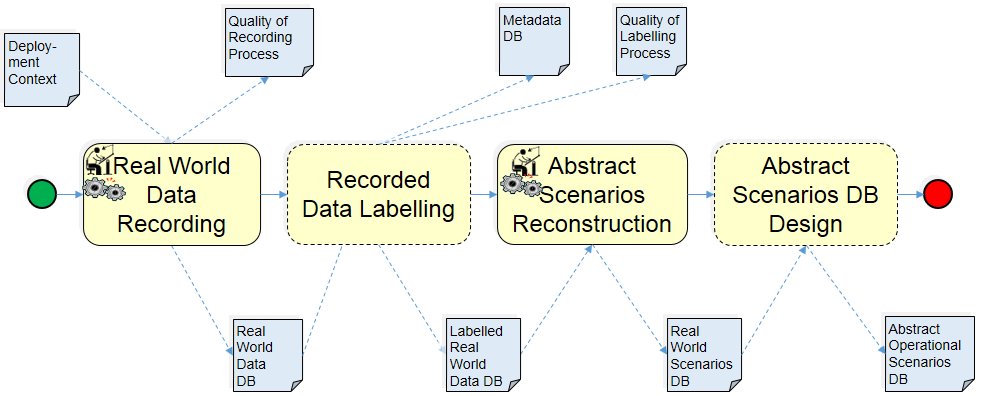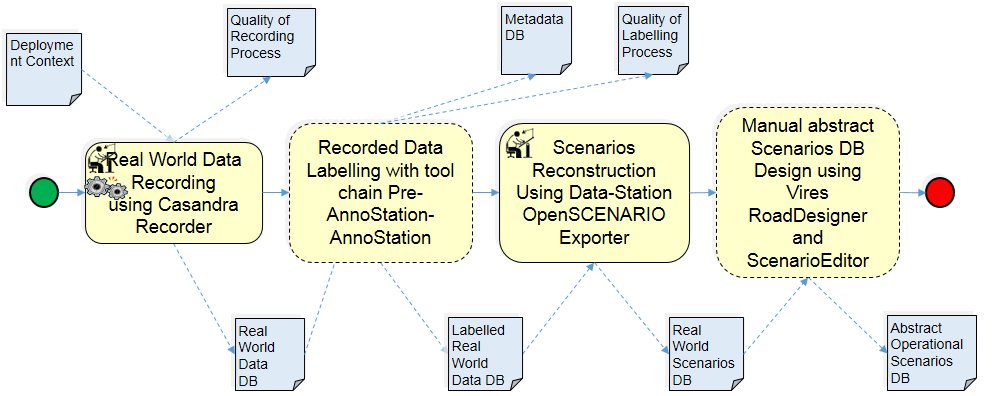Abstract Scenarios Mining
Meta-Information
Origin: Eike Möhlmann / OFFIS
Written: May 2019
Purpose: Mining of abstract scenarios covering the deployment context of the SUT.
Context/Pre-Conditions: The deployment context should be known in order to focus on recording data in the deployment context.
To consider:
– Optionally, further knowledge about the requirement that the SUT has to satisfy can be exploited e.g. for recording data with lower accuracy or with higher criticality. However, this needs to be taken into account in the following steps.
– If the requirements are incomplete or inconsistent, then the safety and security analysis has to be repeated/refined.
– If the representativeness of the abstract scenarios catalog regarding the derived requirements is too low, then more real world data has to be recorded or the abstract scenarios catalog has to be improved.
Structure

Participants and Important Artefacts
Deployment Context: A description of the context in which the SUT will be deployed. This restricts the environment to the relevant operation conditions (like the highway for the highway chauffeur).
Real World Data DB: A set or catalog of recorded/measured data which have been reconstructed from real world data by observing the deployment context of the SUT.
Meta data DB: Additional data based on, e.g., CAN/Flexray, Maps, GPS data required to complete the description of real scenarios, e.g. driven trajectory and maneuver.
Labelled Real World Data DB: A set or catalog of labelled recorded/measured data which have been reconstructed from real world data by observing the deployment context of the SUT.
Real World Scenarios DB: Scenarios that have been reconstructed from annotated/labelled real word recordings/observations/measurement.
Abstract Operational Scenarios DB: A set or catalog of abstract scenarios which have been reconstructed from real world data by observing the deployment context of the SUT.
Quality of Recording Process: Information related to the quality of the recorded data, e.g. color depth, pixel resolution, independence of data points.
Quality of Labelling Process: Information related to the quality of the labelling process, e.g. rates of false classifications, miss rates.
Actions/Collaborations
Real World Data Recording: Recording/Measuring of data from the real world in the deployment context of the SUT (e.g. highway for a highway chauffeur).
– Different content types possible, e.g. images/videos, speed and acceleration.
Recorded Data Labeling (see external (sub-)pattern):Annotating and Labeling of the recorded data (features like car, pedestrians, lanes, infrastructure, …).
Abstract Scenarios Reconstruction: Reconstruct scenario in an scenario exchange format from the labelled recorded real world data.
Abstract Scenarios DB Design: Creation of a set of abstract scenarios and models which should represent the real world.
Discussion
Benefits: The scenarios catalog can be used for further analysis and simulations.
Comments: The quality of the scenarios catalog is relative to the quality of the recorded data (covering the deployment context) and the labelling process (including all relevant objects for reproducing the recorded data).
Application Examples
This pattern was applied to derive scenario catalogues in following use cases:
ENABLE-S3 UC2 “Intersection Crossing using ACPS”
ENABLE-S3 UC6 “Valet Parking”

Relations to other Patterns
| Pattern Name | Relation* |
| Requirements and Scenarios Elicitation | This pattern finds (abstract) scenarios for the Requirement and Scenario Elicitation pattern |
| Recorded Data Labelling | Recorded Data Labelling prepares (visual) data for extracting scenarios |
| Abstract Scenarios DB Design | Creates a set of abstract scenarios that represents the real world |
* “this pattern” denotes the pattern described here, “that pattern” denotes the related pattern
